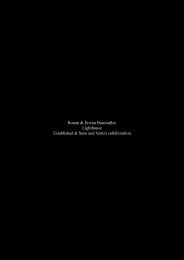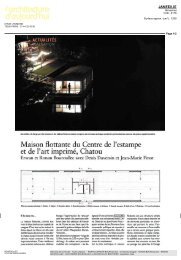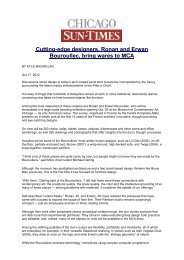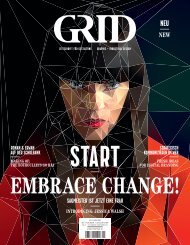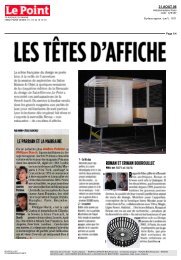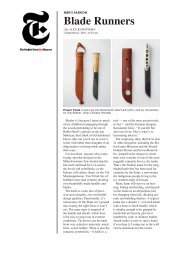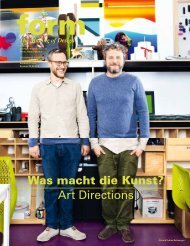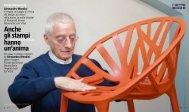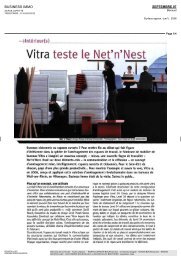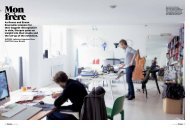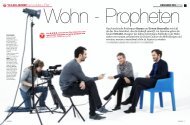pdf of vegetal - Ronan et Erwan Bouroullec
pdf of vegetal - Ronan et Erwan Bouroullec
pdf of vegetal - Ronan et Erwan Bouroullec
- No tags were found...
You also want an ePaper? Increase the reach of your titles
YUMPU automatically turns print PDFs into web optimized ePapers that Google loves.
Growing a Chair<strong>Ronan</strong> & <strong>Erwan</strong> <strong>Bouroullec</strong>The initial intuition was that <strong>of</strong> a chair which would sprout up likea plant. A <strong>veg<strong>et</strong>al</strong> chair, its branches gently curving to form the seatand back. It comes from this fascination we have for various types<strong>of</strong> old furniture, which is plant-inspired. Garden chairs <strong>of</strong> Englishorigin, structured in boughs <strong>of</strong> cast iron, for example; various itemsformed using real branches; or even those armchairs designedin the United States during the first half <strong>of</strong> the last century, usingbushes whose growth had been restricted until they took on theform <strong>of</strong> a chair. Objects which, in short, take us back to a timewhen forms were perhaps a little bulkier, less sleek or smooththan nowadays. There was therefore, from the outs<strong>et</strong>, a desire tocreate an original structure, based on a complex and narrative form<strong>of</strong> construction. Coupled with an inclination for highly advancedtechniques, such as plastic injection moulding, which opens theway to mass distribution.The initial designs show a chair that has the fluidity and uniformelegance <strong>of</strong> a plant: a great unity <strong>of</strong> form whilst at the same timebeing, in essence, untamed [fig. 4].They immediately appealed to Rolf Fehlbaum, but theircomplexity posed the question <strong>of</strong> industrial feasibility. This led to thestart <strong>of</strong> close collaboration with the team led by Egon Bräuning, head<strong>of</strong> the development department, which was to last almost four years.The main issue was to follow the realistic geom<strong>et</strong>ry <strong>of</strong> a chair, whilstat the same time using the principles <strong>of</strong> plant-like branching asa construction model [figs. 2, 3, 5]. What we felt was possible in orderto maintain the integrity <strong>of</strong> our proposed design was approachedin stages, whilst asking questions about its compatibility with themanufacturing process. Take Algues for example, developed byVitra in 2004 [fig. 1]. Its branching form was shown to be particularlysuited to the requirements <strong>of</strong> plastic injection moulding. Thisprocess consists <strong>of</strong> injecting the liquid material, under very highpressure, into a steel mould [fig. 26]. Just like the sap in a tree trunk,it has to circulate evenly inside all the branches <strong>of</strong> the mould,congeal and then solidify — and all in less than two minutes, at theend <strong>of</strong> which the piece is extracted. The major difficulty with thisprocess resides in the alchemy which has to take place b<strong>et</strong>ween thematerial, how quickly it moves, the fall in its temperature and itsm<strong>et</strong>hod <strong>of</strong> solidification. In other words, there is a certain number<strong>of</strong> uncertainties to grasp, given that the result must be perfectlyuniform.One <strong>of</strong> the important stages in the process consisted intransforming the branch sections, circular at the outs<strong>et</strong>, into aT-pr<strong>of</strong>ile [figs. 5, 12, 20, 21]. This solution gives b<strong>et</strong>ter structural qualitieswhilst at the same time me<strong>et</strong>ing the demands <strong>of</strong> injection fluidity.As luck would have it, it turned out that this solution reinforced theplant-like aspect <strong>of</strong> the whole piece.Throughout the entire duration <strong>of</strong> the project, the only way <strong>of</strong>conducting an in-depth study into industrial feasibility was torepresent the chair by means <strong>of</strong> our virtual modelling s<strong>of</strong>tware, thatis, an orthonormal digital script, which represents an obstacle tothe refined chaos <strong>of</strong> the organic. Resorting to this working m<strong>et</strong>hod,which consists <strong>of</strong> moving on from a drawing to three-dimensionalrepresentation, is unremitting. Here, we found a subterfuge: havingproduced drawings by hand on large she<strong>et</strong>s <strong>of</strong> paper on a ı:ı scale,these two-dimensional designs were projected onto the surface<strong>of</strong> a shell [figs. 11, 14, 15, 16]. On the seat and the back, this worked fairlywell, as the drawing <strong>of</strong> the branches does not move too much.Instead, there was serious distortion on the slope <strong>of</strong> the armrests.Like an anamorphosis. The distortion <strong>of</strong> the design, when appliedto the form in three dimensions, was a real surprise. The brancheshad to be redesigned. But the real difficulty lay in r<strong>et</strong>aining theirspontaneous aspect. The great ambiguity <strong>of</strong> this project wasto make the very sophisticated technique demanded by plasticinjection moulding cohabit with a necessary po<strong>et</strong>ry that can onlybe obtained through the sensitivity <strong>of</strong> drawing by hand [figs. 7, 8].Plastic chairs usually fall within two distinct groups: either theshell is fixed to the base, or the entire chair is moulded in a singlepiece. In the case <strong>of</strong> Veg<strong>et</strong>al, the solution adopted was different.For b<strong>et</strong>ter stability, the front legs are linked to the shell. In a certainway this causes them to be much more in line with the design <strong>of</strong>the chair. At the back, the legs are glued on. These are two separateparts. Then there was the issue <strong>of</strong> successfully incorporating themin a way that is fluid, but also structured. It was decided to branchout the circular sections <strong>of</strong> the legs to make them match up withthe T-pr<strong>of</strong>ile sections <strong>of</strong> the seat, the objective being to r<strong>et</strong>ain thesuggestion <strong>of</strong> an organic development [fig. 21].As well as the two- and three-dimensional design drawings,throughout the duration <strong>of</strong> the work process, models have enabledthe changes made to be visualized spatially. This part <strong>of</strong> thework was, on the one hand, carried out on very precise models,manufactured by Vitra [figs. 17, 18, 20, 21, 22, 23], and, on the other, on itemsmodelled by us, more sensitively [figs. 9, 10, 12, 13]. During the past year,when the process was speeding up, we were designing directly onto the models provided by Vitra, in order to perfect the position<strong>of</strong> each branch and the accuracy <strong>of</strong> its curve [fig. 19].Veg<strong>et</strong>al could not have existed without the technical sophistication<strong>of</strong> modern s<strong>of</strong>tware, in the same way that it could not have movedon from the finesse intrinsic to the stages <strong>of</strong> design drawing byhand. It is the close association <strong>of</strong> these two processes that has beenso special. The complexity <strong>of</strong> its form, which must be uniform as atree or a flower would be, has continuously forced us to r<strong>et</strong>hink thewhole thing in respect <strong>of</strong> each d<strong>et</strong>ail: one might say, this chair hasbeen redesigned a thousand times.Interview with Constance Rubini, January 2009.
ıAlgue, module in injected polyamide.Vitra, 2004.
2Drawing in felt-tip pen and pencil,October 2005.Study drawing.
3Drawing in felt-tip pen,October 2005.Study drawing showing the image<strong>of</strong> a transparent leaf.
4Drawing in felt-tip pen,October 2005.First study drawing presentedto Vitra marking the birth <strong>of</strong> the project.
5Stereolithographic model, scale ı:5,November 2005.The first three-dimensional modelmade from a three-dimensional data file.
6Stereolithographic model, scale ı:5,November 2005.Rolf Fehlbaum’s <strong>of</strong>fice.
7Drawings in felt-tip penon digital print-<strong>of</strong>f and photocopies,November 2005.Study for the placement<strong>of</strong> the main and secondary branches.
8Drawing in felt-tip pen on photocopy,November 2005.Study to find the principle for linkingthe branches to the lines <strong>of</strong> the chair.
9Model in glued paper, scale ı:ı,April 2006.First test at actual size.
ı0Shadow <strong>of</strong> a model,April 2006.
ııDrawings in felt-tip pen on paperand digital print-<strong>of</strong>fs,December 2006.Hundreds <strong>of</strong> stages were necessaryto design a balanced structure.
ı2Model in glued paperand poly<strong>et</strong>hylene foam, scale ı:ı,October 2006.<strong>Ronan</strong> and <strong>Erwan</strong> <strong>Bouroullec</strong>.
ı3Model in wood, pvc she<strong>et</strong>and polyur<strong>et</strong>hane resin,December 2006.First models for testing the comfort<strong>of</strong> the seat according to the arrangementand density <strong>of</strong> the branches.
ı4Drawing in felt-tip pen, scale ı:ı,December 2006.A search for arborescence.
ı6Drawing in felt-tip pen,December 2006.Study <strong>of</strong> the interlacing <strong>of</strong> the branches.
ı7Stereolithographic models,January 2007.Models enabling the appearance to be comparedaccording to the width <strong>of</strong> the branches.
ı8Stereolithographic model, scale ı:5,January 2007.<strong>Erwan</strong> <strong>Bouroullec</strong>.
ı9Polystyrene model, digital machining, scale ı:ı,July 2007.Model used for testing the comfort <strong>of</strong> the seat.Final adjustment to the painting<strong>of</strong> the designs <strong>of</strong> the branches.
20Model in high-density polyur<strong>et</strong>hane foam,digital machining, scale ı:ı,January 2008.Model for checking the ribsand the final d<strong>et</strong>ails.
2ıModel in high density polyur<strong>et</strong>hane foam,digital machining, scale ı:ı,January 2008.Model enabling the balance<strong>of</strong> the ribs to be checked.
22Mould in high density polyur<strong>et</strong>hane foam,digital machining, scale ı:ı,March 2008.Mould made by Vitra for producingmodels in vacuum-cast resin.
24Technical drawing, final version,July 2008.Transverse section.
25Technical drawing, final version,July 2008.View from above and below.
26Injection mould installed in the press, steel,September 2008.Principal mould measuring ıı5 × ı42 × ı09 cmand weighing ı4 tonnes.
27Prototype in polyamide,November 2008.Chair resulting from the first injection tests.
28Prototype in polyamide,November 2008.Chair resulting from the first injection tests.
29Final pieces, stacked,November 2008.
30Full range <strong>of</strong> colours for Veg<strong>et</strong>al,November 2008.
Veg<strong>et</strong>al<strong>Ronan</strong> & <strong>Erwan</strong> <strong>Bouroullec</strong>ıAlgue, module in injected polyamide.Vitra, 2004.2Drawing in felt-tip pen and pencil,October 2005.Study drawing.3Drawing in felt-tip pen,October 2005.Study drawing showingthe image <strong>of</strong> a transparent leaf.4Drawing in felt-tip pen,October 2005.First study drawing presentedto Vitra marking the birth<strong>of</strong> the project.5Stereolithographic model, scale ı:5,November 2005.The first three-dimensional modelmade from a three-dimensionaldata file.6Stereolithographic model, scale ı:5,November 2005.Rolf Fehlbaum’s <strong>of</strong>fice.7Drawings in felt-tip penon digital print-<strong>of</strong>f and photocopies,November 2005.Study for the placement<strong>of</strong> the main and secondary branches.8Drawing in felt-tip penon photocopy,November 2005.Study to find the principlefor linking the branchesto the lines <strong>of</strong> the chair.9Model in glued paper, scale ı:ı,April 2006.First test at actual size.ı0Shadow <strong>of</strong> a model,April 2006.ııDrawings in felt-tip pen on paperand digital print-<strong>of</strong>fs,December 2006.Hundreds <strong>of</strong> stages were necessaryto design a balanced structure.ı2Model in glued paperand poly<strong>et</strong>hylene foam, scale ı:ı,October 2006.<strong>Ronan</strong> and <strong>Erwan</strong> <strong>Bouroullec</strong>.ı3Model in wood, pvc she<strong>et</strong>and polyur<strong>et</strong>hane resin,December 2006.First models for testingthe comfort <strong>of</strong> the seat accordingto the arrangement and density<strong>of</strong> the branches.ı4Drawing in felt-tip pen, scale ı:ı,December 2006.A search for arborescence.ı5Drawing in felt-tip pen, scale ı:ı,December 2006.A search for arborescence.
ı6Drawing in felt-tip pen,December 2006.Study <strong>of</strong> the interlacing<strong>of</strong> the branches.ı7Stereolithographic models,January 2007.Models enabling the appearanc<strong>et</strong>o be compared accordingto the width <strong>of</strong> the branches.ı8Stereolithographic model, scale ı:5,January 2007.<strong>Erwan</strong> <strong>Bouroullec</strong>.ı9Polystyrene model,digital machining, scale ı:ı,July 2007.Model used for testing the comfort<strong>of</strong> the seat. Final adjustmentto the painting <strong>of</strong> the designs<strong>of</strong> the branches.20Model in high-density polyur<strong>et</strong>hanefoam, digital machining, scale ı:ı,January 2008.Model for checking the ribsand the final d<strong>et</strong>ails.2ıModel in high density polyur<strong>et</strong>hanefoam, digital machining, scale ı:ı,January 2008.Model enabling the balance<strong>of</strong> the ribs to be checked.22Mould in high density polyur<strong>et</strong>hanefoam, digital machining, scale ı:ı,March 2008.Mould made by Vitra for producingmodels in vacuum-cast resin.23Painted model, vacuum-cast resin,May 2008.Analysis <strong>of</strong> the final d<strong>et</strong>ails.24Technical drawing, final version,July 2008.Transverse section.25Technical drawing, final version,July 2008.View from above and below.26Injection mould installedin the press, steel,September 2008.Principal mould measuringıı5 × ı42 × ı09 cmand weighing ı4 tonnes.27Prototype in polyamide,November 2008.Chair resulting from the firstinjection tests.28Prototype in polyamide,November 2008.Chair resulting from the firstinjection tests.29Final pieces, stacked,November 2008.30Full range <strong>of</strong> colours for Veg<strong>et</strong>al,November 2008.
Design:ÉricandMarie, ParisPhotography and drawings:1–23, <strong>Ronan</strong> & <strong>Erwan</strong> <strong>Bouroullec</strong>;24–26, Vitra; 27–30, Paul Tahonand <strong>Ronan</strong> & <strong>Erwan</strong> <strong>Bouroullec</strong>.Lithography and printing:GZD, Ditzingen, GermanyRights:The design shown here is protected underlaw. Vitra has been awarded the intangibleproperty rights to manufacture and sell thisproduct by the owners in question and holdsthe exclusive manufacturing and distributionrights worldwide.All intellectual property rights, such astrademarks, patents and copyrights arereserved. Nothing contained in this brochuremay be reproduced without written permission.2009, Art.-No. 09132702www.vitra.cominfo@vitra.com



